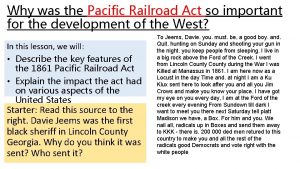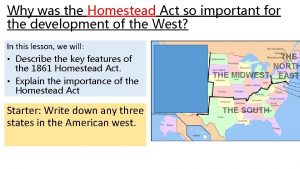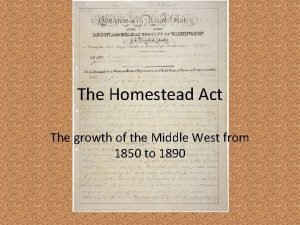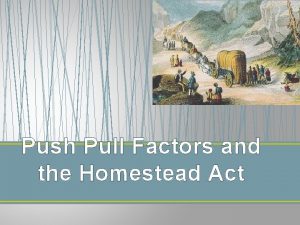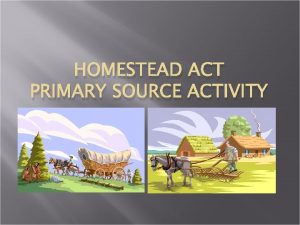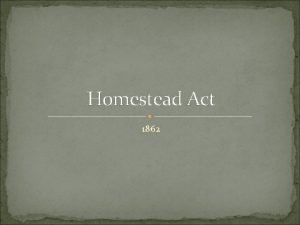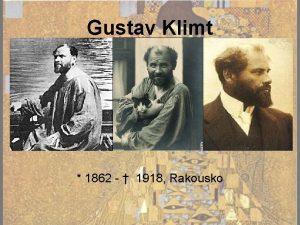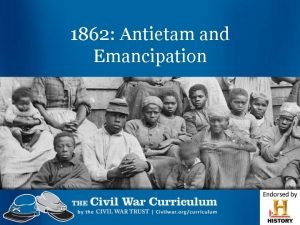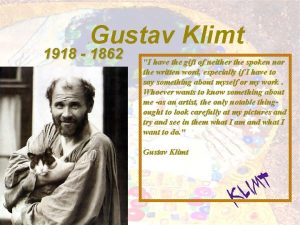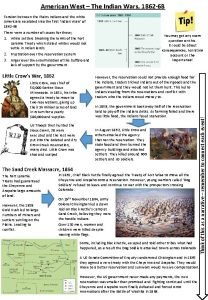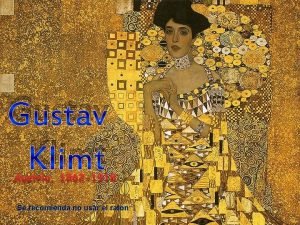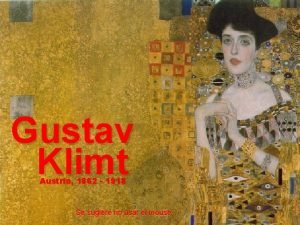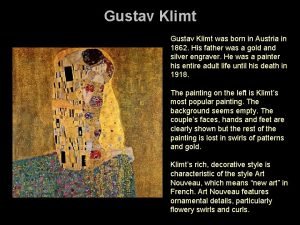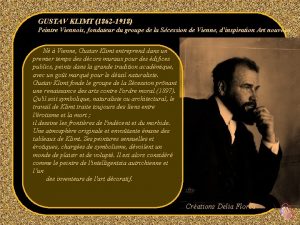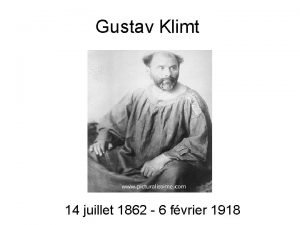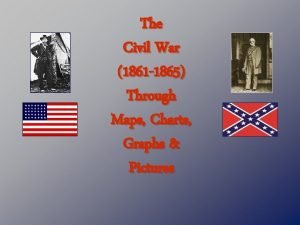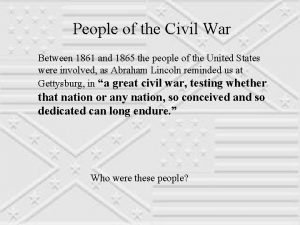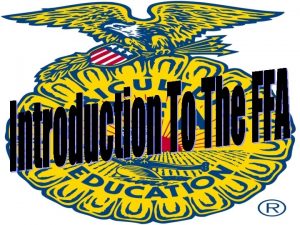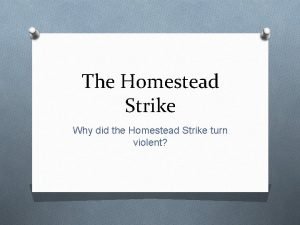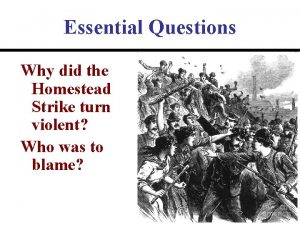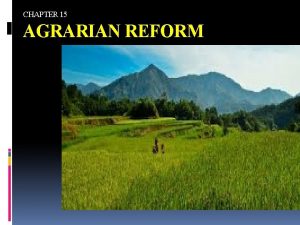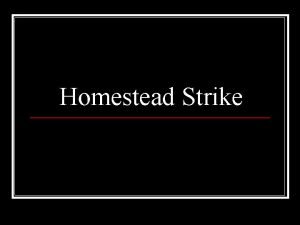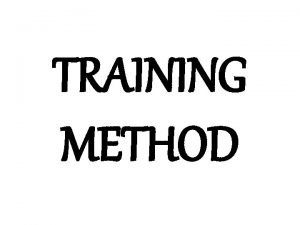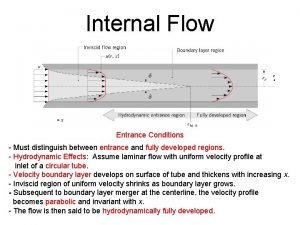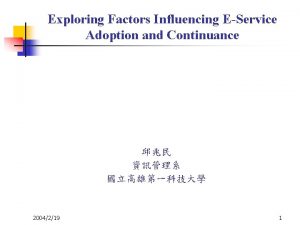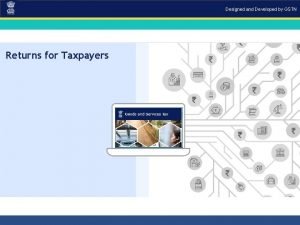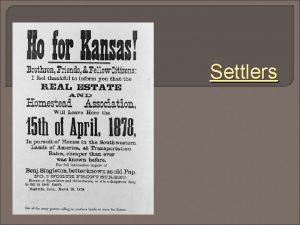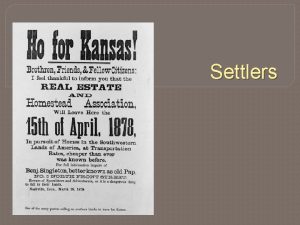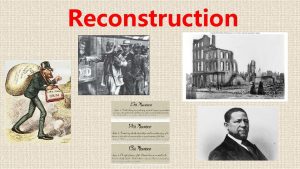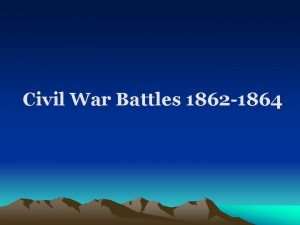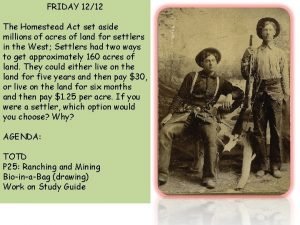Homestead Act was a law developed in 1862

























































- Slides: 57

Homestead Act was a law developed in 1862 by Congress to promote settlement of the Great Plains. Age 21 and the head of the family could have 160 acres of land if they improved it in five years Could buy it for a small amount of $$$

Great Plains-The grassland extending through westcentral portion of the US.

clash v. Differences in land ownership v. Railroad v. Settlers trespassing on Indian Land v. Discovery of gold v. Slaughter of the buffalo v. Broken treaties

• 1871 to 1875, the US supported the extermination of 11 million buffalo.

• Take away the food source from the Native American and they will be forced to submit and go to the reservations. Skull

Destruction of the Buffalo Herds The near extinction of the buffalo.

Tribes of the Great Plains v. Sioux v. Cheyenne v. Crow v. Arapaho v. Kiowa

COWBOYS Original cowboys came from Mexico (Aztec prisoners) They eventually traveled into New Mexico teaching the Pueblo Indians how to ride and rope Today there are many influences from “cowboy” culture.

COWBOYS Let’s see if you can recognize the modern names for these “cowboy” influences

Cowboy True or False? The career of a cowboy lasted from about 25 years of age to about 40 years of age. True 40 was old for a cowboy because of the large amount of riding and work required.

The most frequent cause of death for a cowboy was from Native American’s or cattle rustlers. False Pneumonia or riding accidents caused most cowboy deaths

Cowboys had to be expert marksmen to protect the herd from cattle rustlers and Native American raiders. False A cowboy probably did not carry a gun and even more likely never shot anyone.

Famous Cowboys… …who were probably never cowboys. James Butler “Wild Bill” Hickock Martha Jane Cannary “Calamity Jane”

Cattle Drive Ranchers: Raised longhorn cattle a. Located in southern Great Plains (Texas) b. Profit from demand for beef growing in cities c. Cattle had to be “driven” to the railroads d. Long Drive- Long, dangerous trip: heat, Native Americans, rivers, storms usually happend once a year

Great Plain Settlers Key trails helps western towns grow Chisolm Trial-Texas to Abilene, Kansas Baxter Trail- Texas to Kansas City, MO Goodnight-Loving Trial- Texas to Cheyenne, Wyo.

The End of the Open West Overgrazing Drought and Cold Caused farmers to focus on smaller herds The invention of Barbed wire helped them fence the herds The open west was no more (around 1887 -88)

Chisolm Trail

Great Plain Settlers (3) Farmers-Lived on plots of land called homesteads a. Homestead Act (1862)- federal gov’t plan to give 160 acres of free land to any settler who world move out west and improve the land for 5 years. b. Exodusters- nickname for African Americans who moved out west to escape the problems of South and receive free land c. Lived in Sod Houses; Nicknamed a “Soddy” or “Soddies” d. Faced hardships: droughts, Native Americans attacks, loneliness

Railroad opens the West The federal government gave railroad companies a lot of land for laying track 1867 two companies begin a race to the middle

Central Pacific Railroad moved East from Sacramento, California Union Pacific Railroad moved WEST from Omaha, Nebraska

May 19, 1869 they met at Promontory Point, Utah

Great Plain Settlers II. Problems Faced on the Great Plains a. Conflicts with Railroads 1. Railroads received huge land grants, then sold to settlers at higher prices 2. Railroads were the only link to East and West 3. Corrupt Business Practices of Railroads a. Monopolies- Few lines went through the Great Plains. Settlers faced high prices as a result b. High Freight Rates- amounts charged for shipping goods “Long haul vs. Short haul” dispute upset settlers

Despite these problems thousands moved west to farm the land

A Pioneer’s Sod House, SD Soddy—homes on the western frontier built out of bricks of turf.

Lived in dugouts and soddies

Great Plain Settlers e. Technology needed to make farming more productive on the Plains 1. Steel Plow-to break up the thick soil (sod) 2. Steel Windmill- needed to pump underground water 3. Mechanical Reaper- to harvest crops 4. Barbed Wire- to prevent animals from destroying crops 5. Transcontinental Railroad/Refrigerated Cars- to transport crops to market for sell

Map 13 of 45

CONFLICTS WITH INDIANS

Sitting Bull and Crazy Horse Sitting Bull (Sioux) and Crazy Horse (Cheyenne) were two chiefs who refused to sign the treaty. They defiantly left the reservation. "One does not sell the earth upon which the people walk" Crazy Horse

The Battle of Little Big Horn 1876 v. He was heavily outnumbered and trapped. v. Custer & all 220 of his men died. v“Custer’s Last Stand” outraged Americans and led to govt. retribution. v. The Sioux and Cheyenne were crushed within a year.

Chief Joseph, Nez Perce Nez Percé tribal retreat (1877) • Refusing to go to the reservation, he led his tribe on a 1, 400 march trying to get to Canada. Trying to meet up with Sitting Bull. • Eventually surrendered. • In 3 months, the band of about 700, 200 of whom were warriors, fought 2, 000 U. S. soldiers in 4 major battles and skirmishes

Battle of Wounded Knee – Dec. 1890 7 th Calvary rounded up starving and freezing Sioux and attempted to confiscate all weapons Violence erupted, 300 Indians and 25 whites lay dead. This is the last of the Indian conflicts.

Dawes Act of 1887 v. Quicker Americanization Assimilate, mainstreamed and absorbed into US society Adopt Christianity and White education Individual land ownership v. Abandon farmers tribe, culture and become

Indian Assimilation Attempts Native American children were taken to offreservation Indian schools where they would be taught white man’s ways.

MEANWHILE Back in the Eastern cities…. .

The Emergence of Political Machines Political Machine • Organized group that controls a city’s political party • Give services to voters, businesses for political, financial support • After Civil War, machines gain control of major cities

• Corrupt political leader put New York City in debt • Kept Democratic Party in power in NYC called Tammany Hall • Formed the Tweed Ring • Bought votes, encouraged corruption, controlled NYC politics

v. Exposed for his corruption by cartoonist and editor, Thomas Nast Tweed Ring fell and 1873 Tweed convicted of embezzlement v v. Later Tweed was arrested on a civil charge and jailed in NYC, later died there

1876 Election * • Tilden did not receive enough electoral votes. • Special Commission gives votes to Hayes. • Hayes wins the election • Democrats refuse to recognize Hayes as President *Disputed Electoral votes 164 369 total electoral votes, need 185 to win.

Rutherford B. Hayes Samuel Tilden v. The election of 1876 and the Compromise of 1877 are referred to as the Corrupt Bargain. v. The Democrats and Republicans work out a deal to recognize Hayes as President v. In return, President Hayes must end Reconstruction and pull the Union troops out of the South.

An economic belief supported by the U. S. that opposes the government regulating business. v. Laissez-faire means ‘allow to be’ in French or the government stays out of you business. v. Laissez faire supports our economic system of capitalism

Credit Mobilier • Phony construction company owned by stockholders of Union Pacific Railroad. • Hired Credit Mobilier to build the transcontinental railroad • Charged the U. S. government nearly twice the actual cost of the project. • Bribed Congress to stop the investigation. • Largest scandal in U. S. history, and led to greater public awareness of government corruption.

Whiskey Ring • A group of President Grant’s officials imported whiskey • Used their offices to avoid paying taxes • Cheated US treasury of millions. Salary Grab • Congress gave itself a raise, $5, 000 to $7, 500 annually. • Congressmen received a retroactive check for $5, 000, plus their raise…… • Became a political issue…. Later repealed.

v. In 1856 Henry Bessemer devised a way of converting iron into steel on a large scale. v. His invention involved blowing air through molten iron in a converter, or furnace, in order to burn off the excess carbon. v. His invention revolutionized the Industrial Age. New Uses for Steel v. Steel used in railroads, barbed wire, farm machines v. Changes construction: Brooklyn Bridge; steel-framed skyscrapers

Farmers Unite to Address Common Problems Review of problems for farmers in the late 1800 s: Trapped in debt due to mortgaging Banks foreclosing on mortgages Railroads were taking advantage of farmers by overcharging transportation fees Prices of crops were falling Good farming land was becoming scarce

Economic Distress During the Civil War, the US had issued almost $500 million in paper money, called greenbacks They could not be exchanged for silver or gold They were worth less than hard money of the same face value �Hard money was coins and paper money printed in yellow ink that could be exchanged for gold


Retirement of the Greenbacks After the war, the gov’t began taking greenbacks out of circulation, but this had more effects on the farmers: Increased value of hard money Farmers now had to pay back loans using money that cost more than the money they actually had At this time, they were still receiving less money for their crops �Between 1867 -1887 – a bushel of wheat fell from $2 to 68 cents

Problems with the Railroads Why were the railroad companies able to charge so much for shipping and storage? BECAUSE THERE WAS NO COMPETITION Union Pacific and Central Pacific partook in a merger – since there were no other western railroad companies - they could charge whatever price they wanted and the farmers had no other option, so they had to pay In addition – grain brokers and merchants met with railroad companies secretly to determine market prices of crops


The Farmer’s Begin to Fight Back In 1867, Oliver Hudson Kelley started the Patrons of Husbandry, an organization for farmers that became popularly known as the Grange Its original purpose was to provide a social outlet and an educational forum for isolated farm families But by the 1870 s, Grange members spent most of their time and energy fighting the railroads Their plan was to set up farmers’ cooperatives and teach farmers how to organize and encourage state legislature to regulate railroads


Granger State Laws Munn v. Illinois (1876) State representatives voted into office by members of the Grange who in turn represented the interests of farmers and passed state laws regulating railroad 18 states. Supremeprices Courtin decision stating that states had the ability to regulate private property if it affected public interest.

The Plight of the Farmers

BETWEEN 1860 TO 1877 • Elevator---1852 • Bessemer Process---1852 • Sewing Machine---1853 • Dynamite---1867 • Typewriter---1868 • Levi Blue Jeans/Basketball---1873 • Telephone---1876 Between 1800 to 1900, US Govt. issued 500, 000 patents

National Labor Union • William Sylvis, 1866 • Skilled, unskilled, farmers but excluded Chinese… • Cooperatives, 8 hr. work day, against labor strikes • Founded a political party in 1872 • Involved in the Chinese Exclusion Act • Lost election, faded away • Replaced by Knights of Labor.

Railroad Workers Organize v The Great Railroad Strike of 1877 Railway workers protested unfair wage cuts and unsafe working conditions. The strike was violent and unorganized. President Hayes sent federal troops to put down the strikes. −From then on, employers relied on federal and state troops to repress labor unrest.
 Pacific railway act
Pacific railway act Whats the homestead act
Whats the homestead act Chspee
Chspee Push-pull factor definition
Push-pull factor definition Homestead act primary source
Homestead act primary source Homestead act
Homestead act Soddies definition
Soddies definition 1918-1862
1918-1862 1862 antietam and emancipation answer key
1862 antietam and emancipation answer key 1918-1862
1918-1862 1918-1862
1918-1862 The indian wars 1862-68
The indian wars 1862-68 Nato 1862
Nato 1862 1918-1862
1918-1862 1918-1862
1918-1862 Simbolismo pictorico
Simbolismo pictorico 1918-1862
1918-1862 El peto klimt
El peto klimt Peintre viennois
Peintre viennois 1918-1862
1918-1862 Civil war 1861/1862
Civil war 1861/1862 Civil war 1861/1862
Civil war 1861/1862 National vocational act
National vocational act Macbeth act 2 summary
Macbeth act 2 summary Newton's first law and second law and third law
Newton's first law and second law and third law Newton's first law of motion
Newton's first law of motion Boyle's law charles law avogadro's law
Boyle's law charles law avogadro's law Boyle's law charles law avogadro's law
Boyle's law charles law avogadro's law Homestead strike definition
Homestead strike definition Homestead strike timeline answer key
Homestead strike timeline answer key Http //camillasenior.homestead.com/motion graphs.pdf
Http //camillasenior.homestead.com/motion graphs.pdf Homestead appliance repair
Homestead appliance repair Adopted bayan-anihan
Adopted bayan-anihan Somerset academy south homestead
Somerset academy south homestead Mars homestead project
Mars homestead project Homestead pennsylvania tourism
Homestead pennsylvania tourism Trec florida
Trec florida Homestead sitebuilder windows 10
Homestead sitebuilder windows 10 Developed country
Developed country Application of water jet machining
Application of water jet machining Unix was originally developed in
Unix was originally developed in Comparative education in developing countries
Comparative education in developing countries Hirschi's social bond theory
Hirschi's social bond theory Circuit training method was developed by
Circuit training method was developed by Electric force
Electric force Chronic care model wagner
Chronic care model wagner Developed country
Developed country Neutral stimulus
Neutral stimulus Ldc vs mdc
Ldc vs mdc Cocomo i
Cocomo i Entrance length
Entrance length Linguagem de radio px
Linguagem de radio px What is reynolds number in fluid mechanics
What is reynolds number in fluid mechanics The expectancy model is developed by -
The expectancy model is developed by - Least developed country
Least developed country Which was the most important industry in the sangam age
Which was the most important industry in the sangam age Real self vs. ideal self
Real self vs. ideal self Designed & developed by gstn
Designed & developed by gstn
